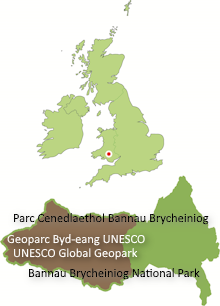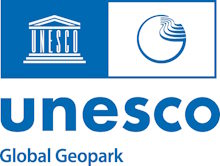The diverse geology of the Geopark is reflected in the use over many centuries of its native stone for buildings of every shape and size.
Coal Measures
‘Blue’ Pennant Sandstone which occurs widely to the south of the Geopark has been used for everyday buildings in the South Wales Coalfield valleys and for grander buildings such as Cyfarthfa Castle in Merthyr Tydfil, just outside the Geopark. It does not outcrop naturally in the Geopark but continues to be imported into the area for a variety of buildings, eg:
- Royal Oak public house, Sennybridge
A blue/grey variety of Pennant Sandstone from the Forest of Dean has perhaps been imported for the construction of Brecon Barracks.
The Farewell Rock has been used for buildings in such places as Brynaman, Pen-y-cae and Ponsticill.
Carboniferous Limestone
The principal use of Carboniferous Limestone has been for dry-stone walls delimiting fields in and around the outcrop of this rock and perhaps most noticeably in areas like Ystradfellte. It has also been used in buildings and can be seen in the walls of Craig-y-nos Castle in the upper Swansea Valley.
It is perhaps most imposingly used in the Geopark in the defensive walls of Carreg Cennen Castle perched atop the cliffs of this same rock which rise high above the Afon Cennen.
Millstone Grit (Twrch Sandstone)
Widely used in field walls in the countryside where it outcrops.
Old Red Sandstone
Geologists assign these rocks to the Devonian and uppermost Silurian periods. The rich red-brown colours of the Old Red Sandstone can be seen in many pubs and churches, farmhouses and ordinary dwellings around the Geopark. Brecon Cathedral includes a maroon sandstone from the St Maughan’s Formation for example, whilst the electricity sub-station at Sennybridge is built from a grey-green sandstone from the Senni Beds Formation.
Where the stone was found to be particularly ‘flaggy’, ie it readily splits into thin sheets, then quarries were opened up to shape this material into roof tiles. The spectacular remains of workings along the outcrop of one such bed of rock, the ‘Tilestones Formation’, can be traced for tens of miles across the countryside at places like Mynydd Myddfai. The roof of Llandyfan Church makes use of the Tilestones.
Bricks made from mudstone within the Old Red Sandstone sequence are also to be seen in places like Brecon.
Silurian and Ordovician stone
Ordovician age sandstones are used in buildings in both Llandeilo and Llandovery on the north-western flanks of the Geopark. The Tilestones referred to above mark the base of the Old Red Sandstone though they are actually of Silurian age.
The northern and western walls of the church at Myddfai incorporate an olive green sandstone from the Sawdde Sandstone Formation.
The mill at Bethlehem includes a grey / olive sandstone from the Llandeilo Flags Formation whilst the former pub at Pont ar Llechau incorporates a sandstone from the Mynydd Myddfai Sandstone Formation.
Further reading
Look out for the bilingual leaflet ‘Geology and building stones in Wales (south)‘ published by the British Geological Survey and available locally through National Park information centres.
Ystradfellte was the subject of a European collaborative project a few years ago and a walk is described which looks at the use of limestone in the area.
The National Museum of Wales published a specialist report by John Davies and Jana Horek on ‘Building Stone Use in the Brecon Beacons National Park’ in 2009. Take a look too at the webpages of the Welsh Stone Forum at the National Museum of Wales.



